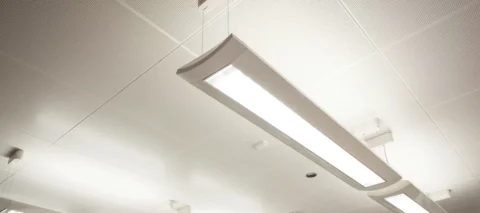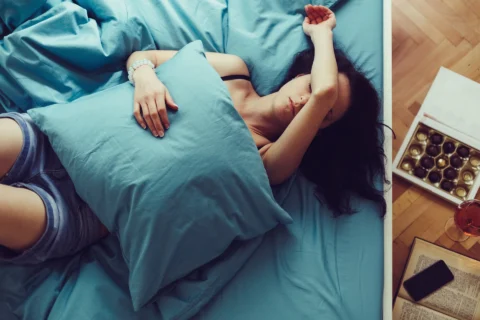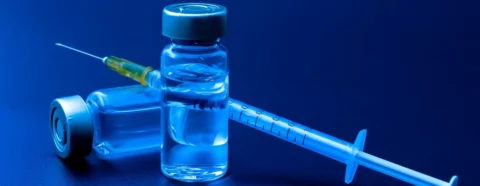Botox is a treatment commonly done to keep forehead wrinkles and nasolabial folds from forming or deepening. Aside from these areas, Botox is also incredibly popular as an FDA-approved procedure for smoothing out the crows feet and glabellar lines around and between the eyes. In recent years, plastic surgeons have begun to promote Botox as a way to get rid of the dark circles and wrinkles below the eyes as well — even though it’s not supported by the FDA yet.
So should you have Botox injected under your eyes? Although it’s an off-label use, many patients do benefit from using Botox under the eyes when injected in conjunction to the lower eyelids and crow’s feet. Bags and wrinkles in the areas surrounding the eyes could be reduced in as little as 8 units for each eye, but not without side effects.
How Botox Works
Botox is one of the most in-demand cosmetic surgery procedures worldwide, well-known for its ability to paralyze specific facial muscles from tightening and contracting. It’s sought after by patients who want to minimize the wrinkles on their faces. But before we discuss the nitty-gritty of how Botox can reduce dark circles and delicate wrinkles under the eyes, it’s important to first understand how the Botox cosmetic itself works.
The ingredients that make up Botox are botulinum toxin type A, human albumin, and sodium chloride. Botulinum toxin is derived from the C. botulinum bacteria, which is commonly found in natural settings like lakes, forests, and soil. Although this bacteria is generally harmless, it can become incredibly dangerous when its spores transform and its cell population increases.
When the C. botulinum bacteria evolves, it will begin producing the deadly neurotoxin responsible for botulism. Scientists have managed to dilute the neurotoxin from its natural form to manufacture medical products like Botox, which is perfectly safe to use with few side effects.
Botox works by blocking the release of acetylcholine, the chemical messenger which signals the muscle cells to contract. When injected, Botox can temporarily relax the muscles and help them become less stiff. After around 3 – 6 months, the effects of Botox wear off and the muscles will begin to contract again.
For patients who have muscle or nerve disorders and similar medical conditions, Botox is often prescribed as a treatment to provide temporary relief. And of course, Botox is most famous as a medication that weakens dynamic muscles and reduces the appearance of wrinkles. It’s frequently used to correct horizontal lines on the forehead, ‘cobblestone’ skin on the chin, lines at the corners of the mouth, and wrinkles between the eyebrows or the corners of the eyes.
Botox Efficacy For Eye Wrinkles
Since the late 1980s, Botox has been the go-to treatment for a number of wrinkle types. In the US, Botox was approved to reduce the appearance of glabella lines between the eyes in 2002, and crow’s feet at the corners of the eyes in 2013. However, the US FDA has yet to approve the use of Botox under the eyes for cosmetic purposes. Currently, there is not enough research that shows the effectiveness and potential side effects of Botox for wrinkles and bags directly under the eyes.
The 2003 Study
In one study with nineteen female participants, some researchers tried to see where Botox could most effectively target wrinkles around the eyes. Some participants received injections in the lower eyelid skin and in the corners of their eyes, while others were injected under the eyes only. The participants who were injected in combined areas found positive results, as the creases around their eyes were minimized.
Their lower eyelids also appeared fuller and plumper, reducing wrinkles and bagginess, compared to those who were injected solely in the muscles below the eyes. Researchers also tried to measure the effects of varying the amounts of Botox injected into the lower eyelids. Patients who received 8 units of Botox observed the strongest results, but experienced the most intense side effects as well.
As this study is the only one available that tackles the question directly, injecting Botox to treat bags and dark circles under the eyes is still an off-label use. Although many providers are unsure about the efficacy of this treatment, some cosmetic surgeons still try to soften the appearance of under-eye wrinkles with Botox — and find success in it.
It usually depends on whether the wrinkles under the eyes are deep, dynamic wrinkles rather than delicate, fine lines. Botox won’t be able to resolve creases completely; most providers would recommend dermal facial fillers, fat transfer, or laser resurfacing as a better treatment option instead. For the patients who do receive Botox below their eyes, they observe that there isn’t a dramatic difference immediately. It may take approximately 3 – 7 days or even a month to see results. And the effects eventually wear off after 3 – 6 months, much like in other treatment areas.
What To Expect For Under-Eye Botox Treatment

As you get older, your skin begins to reflect your age. You’ll notice many changes, especially around your eyes, as creases and sagging bags of skin develop underneath. For these problems, Botox is occasionally recommended as an off-label procedure to reduce the appearance of under-eye wrinkles.
However, Botox is very rarely injected under the eyes as a standalone treatment; more often, Botox is injected in the lower eyelids as part of the treatment for crow’s feet. Here are some things you can expect if you’re planning to undergo this type of cosmetic procedure:
The Procedure
Every Botox injection should be performed in a doctor’s office and administered by a board-certified dermatologist, plastic surgeon, or physician who was specially trained in Botox injections. It’s important to find a skilled provider because they are the ones who are most familiar with facial anatomy, so they can deliver safe and effective results.
Once you’ve consulted with an experienced Botox injector to see if you’re a suitable candidate, you will need to return to their office for the procedure.
- Your Botox provider may apply an anesthetic to the injection site to ease any pain or discomfort. The anesthetic will numb your skin so you won’t really feel the small Botox needles later on.
- The provider will then mark the injection sites based on how you move your facial muscles. For the lower eyelid, the ideal dose is around 8 units or one to two injections per side. Compared to other treatments, the Botox dose is much lower for the eyes to prevent increased risks of complications.
- They will inject the Botox using small needles into the lower part of the orbicularis oculi, which is the muscle that closes the eyelids.Some doctors may also use a wrinkle filler in conjunction with your Botox injection. It will take no more than 30 minutes to complete the whole process.
- Afterwards, you’re free to return to your normal activities immediately. As Botox is a non-surgical cosmetic treatment, it’s perfect for patients who don’t want to undergo any downtime. Patients are also allowed to reapply makeup to cover temporary redness at the injection site.
The Cost
The overall cost of Botox varies depending on your region and the specialist. Aside from the medication, you’re also paying for the office space, the time and expertise of your provider, and other materials.
In urban areas where there is a lot of competition, you’re more likely to find more affordable Botox rates, especially when compared to rural areas where no other injector is providing the service. Before requesting for Botox injections under your eyes, it’s a good practice to ask for a reasonable price estimate.
Botox is currently priced at around $12 per unit. With the 16 – 24 Botox units for crow’s feet, you may need to spend around $300 – $400 for an initial treatment session, plus more for maintenance top-ups. Men would also need more Botox units than women because they have stronger muscles, so the cost of the procedure may be more expensive for them.
Learn more: 4 Ways To Save Money Before Your Next Botox Treatment
Botox for The Brow and Other Eye Conditions
When people think about Botox, they mostly think of it in a purely cosmetic sense. They may be surprised to learn that Botox is actually an effective treatment for a number of medical conditions, including hyperhidrosis (excessive sweating), neck spasms, and chronic migraines. Ophthalmologists also utilize Botox around or under the eyes to treat eye issues that impact vision. From frown lines and crow’s feet to lazy eye, eye twitching, and more, Botox is an incredibly versatile product:
- Crow’s feet: Crow’s feet are the lines that appear at the corners of our eyes which give it an old and tired appearance. When Botox is injected directly into the muscles that create crow’s feet, it relaxes the edges of the eye and causes the skin to look firmer and smoother.
- Glabellar lines: Glabellar lines are also known as frown lines or glabella lines; these are the wrinkles that look like a number ‘11’ between your eyes and below your forehead. Botox can relax and minimize these lines, but patients may experience a limited range of expression and a “stiff” appearance.
- Drooping eyelids: A drooping eyelid is sometimes caused by a drooping brow. When the muscles and tendons in that area grow slack due to aging, it can reduce your field of vision and cause the eyelids to sag. Botox can be used for a non-surgical brow lift to relax the muscles and stop them from pulling down on the brow. The extra lift also smooths out skin and diminishes wrinkles in the treatment area.
- Strabismus: Botox was originally invented to treat strabismus (crossed eyes), a condition where the eyes are not aligned. To help the eyes stop from turning inwards or outwards, Botox stops the individual muscles from working temporarily and allows the eye to change its position.
- Lazy eye: Amblyopia, more commonly known as ‘lazy eye’, occurs when there is an imbalance of strength in the muscles that keep the eyes focused and moving together. Sometimes, it is caused by nerve damage around the eyeball or somewhere between the eye and the brain. Amblyopia is common among children; it is treated by placing an eye-patch over the dominant eye in order to build up muscle strength in the other eye.
On the other hand, adults who suffer from lazy eye have an underlying condition that causes it; Botox is only recommended as one of the last approaches to managing the problem.
- ‘Dry’ or ‘teary’ eyes: Excessive dry and teary eyes can be treated with Botox shots. Injecting Botox in the lacrimal gland can temporarily reduce uncontrolled tears, as there may be abnormal nerve connections in this organ. Botox can also provide dry eye relief as well. It does this by paralyzing the orbicularis oculi muscle, which leads to decreased action in the lacrimal pump and improves lubrication on the eye’s surface.
- Blepharospasm: Eye twitching can be an unpredictable and disruptive condition, especially if it becomes chronic. When the muscles around the eye involuntarily spasm, they can force both eyes to close completely and impact the patient’s vision. Botox injections can relieve blepharospasm by relaxing the muscles that affect this movement.
Is Botox Safe To Use?

As with every plastic surgery procedure, it’s crucial to consider how the treatment will achieve your goals. If your goal is to reduce the appearance of dynamic wrinkles, which emerge when you make facial expressions, then Botox can certainly help. Aside from determining your aesthetic goals, it’s also good to see if the procedure is safe for you. You can assess this by doing research on who is an ideal candidate, as well as to check on potential side effects which may occur.
The Ideal Candidate
The best possible candidate for getting Botox injections below the eyes is someone who is over the age of 18 and is already planning to get Botox to address their crow’s feet. They should have healthy muscles and have no chronic neuromuscular condition, or any other serious health conditions like myasthenia gravis, Lambert-Eaton syndrome, and Lou Gehrig’s disease.
This particular Botox procedure is not suitable for patients with impaired eyelid muscles and older individuals with severe facial wrinkles. It’s best to avoid getting Botox done as well if you are pregnant or breastfeeding, as the effects of the product on unborn and nursing babies are yet to be studied.
Side Effects and Risks
Botox has long been applied to a wide range of treatments in the past several decades. It is largely safe. And although it’s not permanent, Botox can offer relief from discomfort, alleviate medical symptoms, and provide life-changing cosmetic effects. However, Botox for under-eye use is not FDA-approved, so there is no full body of research on its safety yet. Still, you can expect commonly-known Botox side effects to occur, such as:
- Pain
- Swelling
- Numbness
- Muscle spasms
- Twitching
- Bleeding
- Bruising
- Dizziness
- Redness
- Rash
- Headaches
- Neck pain
- Nausea
- Flu-like symptoms
These side effects should wear off in a few hours or days after the injection. Aside from common side effects, under-eye Botox poses added risks because the treatment area is very delicate. Some doctors advise against this treatment due to the relatively high risk of weakening the bottom eyelid.
Weakened eyelids can lead to the lower lid pulling away slightly from the eyeball, which can be unattractive and cause a number of problems like dry eyes, blurry vision, difficulty breathing, droopy eyelids, eye swelling, eye numbness, and difficulty opening the eyes. Patients should also be aware of the signs of a Botox allergy; if the following symptoms occur, seek out emergency medical attention at once:
- Seizures
- Fainting
- Vision problems
- Chest pain
- Shortness of breath
- Rash or hives
- Irregular heartbeat
- Facial asymmetry
- Loss of muscle use in the face
- Incontinence
- Voice hoarseness
- Trouble swallowing
- Trouble holding up your head
- Difficulty moving the head
Alternative Treatments To Under-Eye Botox
If you’re concerned about the safety or efficacy of Botox treatment for under-eye wrinkles, you should consider talking to your cosmetic surgeon about other viable options. There are actually many ways to reduce those unwanted eye bags that develop as your skin thins with age. Some great alternatives are:
- Tear trough filler: The tear trough is the deep crease between the bottom eyelid and upper cheek, which casts a shadow below the eyes and results in a tired, aged appearance. Cosmetic fillers (or injectable fillers) are made up of gel-like substances that add volume to the treatment area. Getting an eye filler can result in plumper, smoother under-eye skin. An dermal filler injection, like Juvederm or Restylane Lyft, can volumize the filler treatment site and reduce sagging skin. A hyaluronic acid filler is also a safe choice, as hyaluronic acid is a naturally-occurring substance in our bodies.
- Chemical peels: A chemical peel is often the first choice of plastic surgeons for treating wrinkles under the eyes. When the chemical solution is applied, the skin experiences a deep exfoliation that removes the dead and unhealthy skin cells. What’s left behind after healing is fresh, thicker, and stronger skin that’s less likely to form bags.
- Blepharoplasty: Eyelid surgery is the most appropriate method of reducing lines and wrinkles that form below the eyes. By removing superficial tissues, skin, muscle, and fat that thinned over time, the droopy under-eye area can be lifted and tightened. Blepharoplasty requires only a short recovery time; although it’s mildly uncomfortable, it can yield permanent results
- Laser resurfacing: Much like a chemical peel, laser resurfacing is effective for stimulating collagen growth in aged and damaged skin around the eyes. The heat of the laser triggers cellular regeneration and corrects dark pigment from the fine lines in the target area, leaving smooth and refined skin in its place.
For younger patients who haven’t noticed severe wrinkling and loose skin yet, it may be good to practice at-home strategies and daily habits to prevent under-eye deterioration. Some useful tips to follow are:
- Quit smoking, as it can rapidly deteriorate collagen and elastin in the skin.
- Get at least 7 – 8 hours of sleep at night.
- Sleep with your head slightly elevated to prevent fluid from accumulating under the eyes.
- Avoid sun exposure and wear plenty of sunscreen everyday.
- Treat seasonal allergies that cause puffiness with over-the-counter medications like antihistamines.
- Reduce intake of sodium in your diet; too much sodium can retain water that leads to a buildup of fluids and puffy skin.
- Try an eye cream or other cosmetics specifically designed to tighten under-eye skin, reduce dark eye circles, and minimize mildly puffy eyes.
Ethos Spa: Your Best Botox Partner
Ethos Spa is New Jersey’s premier med spa. With our board-certified surgeon and highly-professional medical team, we bring you the best services in cosmetic surgery. We have performed thousands of Botox procedures on countless patients, so we’re well-aware of various patient concerns, goals, and needs. Ethos Spa prioritizes patient safety and satisfaction above all else; you’re sure to be in good hands with us.
Consult with our well-trained and experienced Botox providers at our luxurious clinic. Schedule your first appointment with us today.







